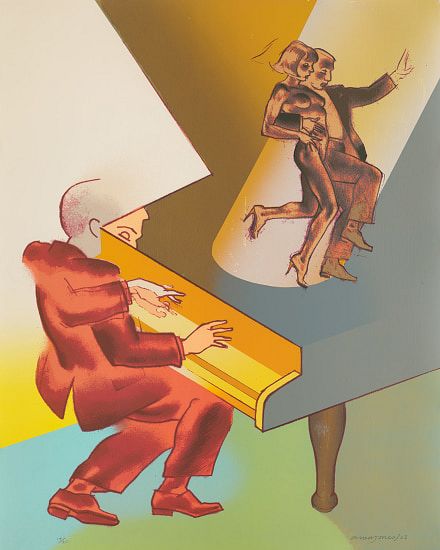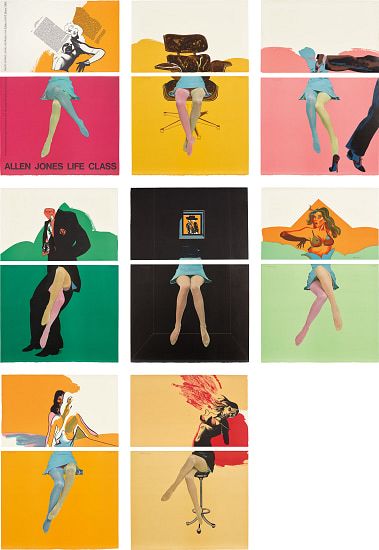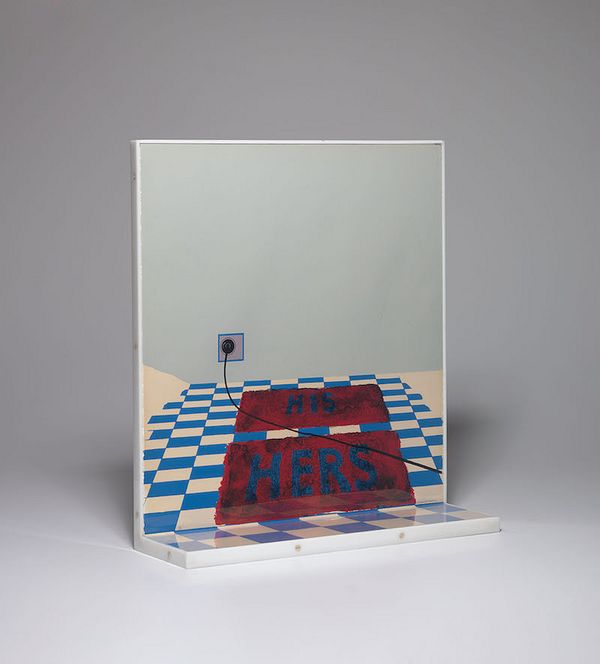Allen Jones, A New Perspective on Floors (Ll. 36 a-f; E.A. 520-525), 1966. Estimate £15,000 - 20,000. Editions London.
Thinking of Allen Jones induces a frisson of satin, gloss, pleasure, and danger; one imagines a world of high-heeled boots and stockinged legs where unreal girls with extravagant attire dance the night away. Enveloped in the intellectual milieu that formed a generation of artists who became instrumental in the nascent British Pop Art movement, Jones walked the tightrope between fine art and commercialization, balancing aesthetic sensation with the guilty, irresistible allure of advertising.

Allen Jones, Come Dancing, from Sheet Music, 2003. Estimate £800 - 1,200. Editions London.
As he toed this line, Jones’ style became distinctly high-keyed and hard-edged, so the ambiguous and instantly recognizable depiction of the female form became an iconic and recurring theme in his work. Jones says, “In 1965 during my first visit to Los Angeles I came across Frederick’s of Hollywood mail order catalogues. The ‘high street glamour’ and cluttered layout of each page worked against the illusionism of the drawings, making the sexiness of the products acceptable in the sunny suburbias of America.” Interested in both stylization and fantasies of the body, Jones started collecting mail-order catalogues for cross-dressing and fetish accessories. The exposure to sleek imagery of contemporary American advertisements and pin-ups, and the surrounding 1960s dress and culture, particularly the mini skirt (think Mary Quant designs), led Jones to focus on the female leg. Steeped in theory but taking the street as his theatre, Jones adopted the clandestine images of partial body parts, and in so doing formed his new iconography.

Allen Jones, Life Class (Ll. 48a-g; E.A. 533-540), 1968. Estimate £12,000 - 18,000. Editions London.
Jones distorts his subjects with an element of colored, seductive fantasy. His figures employ and exaggerate clichés, arousing an emotional response in the viewer. This seeming sexual objectification of women has caused both admiration and outcry. Are the works merely a lure, an aesthetic game? Or perhaps they are the pictorial realization of Jones’ interest in Carl Jung and Friedrich Nietzsche’s theories of the bisexual nature of the human psyche. Using Freudian psychoanalytic theory, Laura Mulvey analyzed Jones’ use of fetishism in 1973, explaining how women’s bodies signify to men the possibility of castration. To diminish castration anxiety the woman must either be made whole again with phallic substitutes (the act of narcissistic completion) or punished for her lack of phallus (the act of difference). The stiletto has come to symbolize both the wearer’s weapon and punishment. However analyzed, Jones represents female form not as it exists in reality, but rather as it exists in the male imagination.
Jones’ graphic work is close to the heart of his creative processes. Printmaking proved especially appropriate for his exploration of fetishism because of its relation to his primary graphic sources. Jones said of printmaking in 1963, “Lithography is now so automatic to me that there is no ceremony attached to working in this medium, hence I tend to develop more original ideas this way, before they appear in my paintings as a sort of automatism.” Of the earliest works Jones made, three print portfolios stand out as exceptional examples of the artist’s oeuvre, capturing his signature motifs and simultaneously inspiring and shocking the viewer.

Allen Jones, A Fleet of Buses (Ll. 37a-e; E.A. 514-518), 1966. Estimate £8,000 - 12,000. Editions London.
In Life Class, 1968, Jones plays a game of “exquisite corpse” with the female form. The lower half of each image is the photolithographic reproduction of a young woman’s legs in brightly colored nylons and mini-skirt; the top half completes the figure in a contrasting style. While the legs are depicted in varying poses, all with pointed toes, subconsciously sexy, and almost coy, the upper bodies are reminiscent of 1940s American pin-ups, overtly objectifying, volatile, and expressive—the secret face of postwar male desire. The viewer is torn between flirtation and provocation. The dialogue between images opens the conversation to the constructs beneath, delving into the perception of femininity, the gender binary, and the evolution of these ideas through the decades. The viewer can actively participate in reconstructing the female form, shuffling the different halves, and creating their own magazine-like collage.
Just as Jones engages the viewer in Life Class, so he encourages creative interaction with both A New Perspective on Floors, 1966 and Fleet of Buses, 1966. Not afraid to challenge convention, in A New Perspective on Floors Jones designed prints to be folded at right angles in order to form the join between the imaginary wall and floor. Observing the sense of perspective, the viewer sees sharpened stiletto heels at floor level, as if the floor pattern is just as important as the femme fatale’s footwear. The folio is accompanied by a specially designed frame, in which the folded print can be presented as the artist intended, with the lowest 6 inches of the image protruding forward. In this way, not only did Jones present a conceptual challenge but offers the viewer a chance to physically engage with the prints, folding the lowest edge, and choosing which of the six prints to present in the frame.

Allen Jones, A New Perspective on Floors, 1966. Estimate £15,000 - 20,000. Editions London.
Made the same year as A New Perspective on Floors, Fleet of Buses presents the entire printed surface of the paper as an art object, with the paper itself shaped to form the outline of the subject matter. Jones tore the lower corners of the sheet from the page in order to show the vehicle “wheels” protruding below. Large swathes of color traverse the images, with only a glimpse of who might be travelling in the buses revealed—a man in a top hat; a lady in a mini-skirt; or a girl in a revealing polka dot blouse. The eccentric shapes subvert the flatness of the lithographic image, as if the viewer has caught a sideways glance of the passing traffic.
These three portfolios show how Jones was addressing contemporary culture as expressed in the imagery of the time. Unafraid of breaking the rules, Jones has pushed the preconceptions of sensuality and glamour by using color, shape and form in intriguing ways. Perhaps because his motif is erotic, or simply defined in the pleasure principle, once seen, his images stay in the mind, pushing and pulling the viewer in a collaborative act of creativity.
Discover More from Editions London >

Recommended Reading
Specialist Picks: Unlikely Pairings, From Dürer to Richter >
The Help Portfolio: 16 Artists Support 16 Charities >
